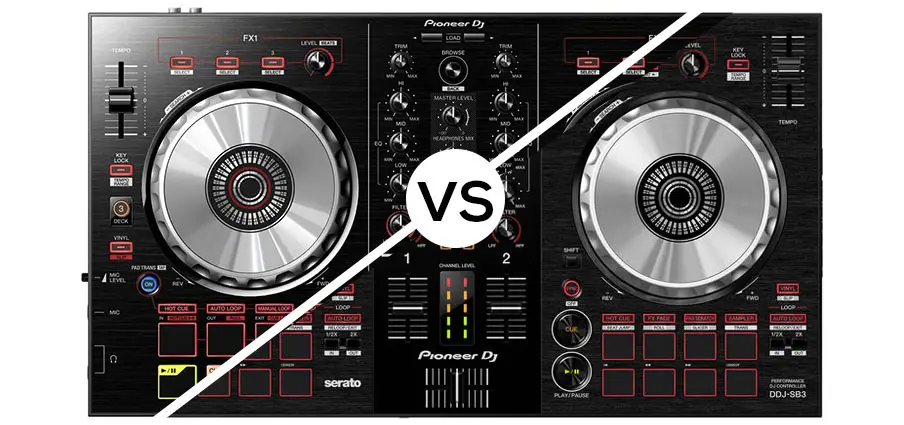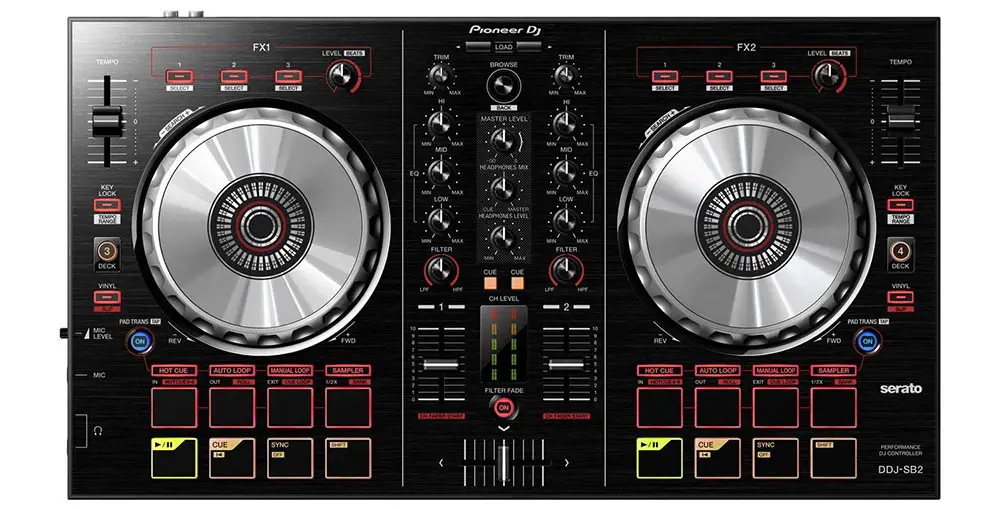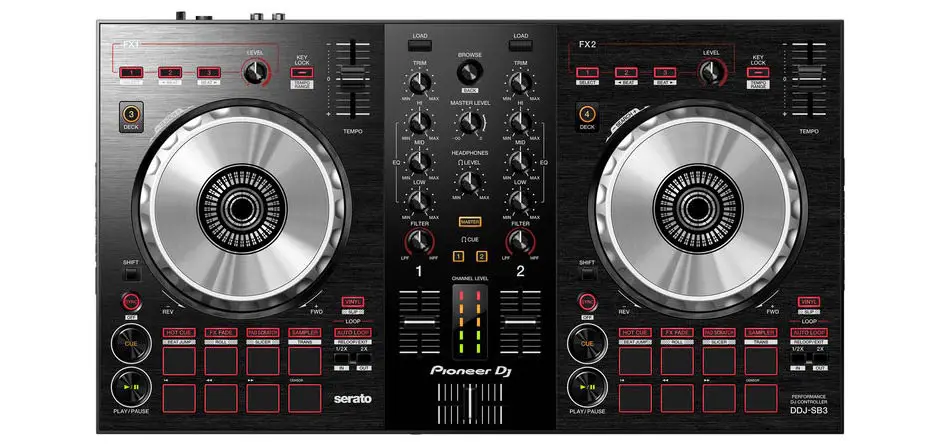Pioneer DDJ-SB2 vs DDJ-SB3 Side-by-Side Comparison
Since their highly successful excursion into the DJ controller world, Pioneer has cranked out a few ‘entry’ level DJ controllers now, namely the DDJ-SB, the DDJ-SB2, and the DDJ-SB3.
Formerly, Pioneer was the name everyone shied away from if they didn’t have the cash to splash. Pioneer products are famously expensive but with the name comes a reputation which is unparalleled in the audio-tech industry.
From car stereos to DJ gear and much more, Pioneer has become a dominant force and it’s been no accident of fate – their gear is bulletproof in its reliability, innovative and it moves dynamically with consumer desire and industry requirements.
However, despite Pioneer formerly being a high-ticket manufacturer, they are now finally providing for the waves of entry and intermediate level DJs who are either entering the fray for the first time or are making the transition from turntables or CDJs. Their cheaper DJ controllers are still not that cheap, but they’re well within the budget of many, especially when compared to CDJs and mixers, etc.

So, what are the main options?
Pioneer’s first full-size DJ controller for entry-level DJs was the DDJ-SB. This is now thoroughly outdated by both the DDJ-SB2 and DDJ-SB3, which are its successors in the same line of products.
Both are compact controller suitable for travel. They’re both relatively inexpensive. They’re both distinctly Pioneer. They’re both equipped with ‘pro’ hardware and features, e.g. 4 deck mode. It’s also worth mentioning that both run by default on Serato and not RekordBox, though they can be mapped to RekordBox and other DJ apps without much difficulty.
Pioneer DDJ-SB2

The successor of the highly popular DDJ-SB, the DDJ-SB2 is superbly rated across users of all types. The build quality is high, the features are efficient and effective and given it lies in the sub $250 range, it’s within many budgets.
Build and Features
This controller obviously looks like a Pioneer and it’s built superbly. It’s really quite small which is a massive bonus for gigging DJs or house party DJ stations.
It has one USB connection for laptops and computers, a master output in the form of RCA jacks, a mic-in and a headphone in.
With Serato DJ Intro boxed with the controller, you can get going right away. It’s worth mentioning that DJ Intro has been replaced by Serato DJ Lite which can be downloaded directly from the Serato website. This is easily upgradable to Serato DJ Pro.
In addition, The DDJ-SB2 is also compatible with Pioneer’s own RekordBox, but given this controller is ‘made for Serato’, you’ll likely get best results out of using that. Furthermore, it’s simple to map this controller to either Virtual DJ or even Traktor – lots of mapping files are available online.
Performance
The DDJ-SB2 is a pro level entry controller and thus, it’s tricked up with everything you need for serious DJing. It has all the expected controls, channel gain trims, 3-band EQs and professional faders, meters and other hardware.
With 4-deck mode, each deck has a switch enabling you to assign it to a 3rd of 4th deck. This is only available with the full version of Serato DJ Pro, though.
An innovative section is the FX pad section which features a pad-trans switch, allowing you to switch the pads into gates or transformer-like effects. The row of pads below hosts cue, play/pause and sync control.
Summary
With 4-deck capability and all the trimmings, this compact controller is still perfect for those looking for low or mid-budget DJ controllers.
Pioneer DDJ-SB3

The successor to the SB2, the SB3 does have more features going for it, and it does cost a bit more. Overall, it’s very similar in build and layout BUT it does pack some features which clearly cut it above its predecessor.
Build and Features
Build quality wise, this controller is identical in form-factor and size. The layout is extremely similar, which is great if you’re transitioning between the two controllers. It’s distinctly Pioneer and whilst it is built from plastic, it doesn’t feel toy-like or unsturdy.
Feature-wise, there is one massive improvement. The DDJ-SB3 comes with dedicated play and cue buttons for each deck. On the DDJ-SB2, each deck only had play/pause and cue buttons built into the pad section. This dedicated setup is far, far better. It’s a major improvement that the SB2 sorely missed.
Another feature is “Pad Scratch”. This helps you emulate scratch FX at the touch of a button. This might seem like cheating and truth be told, it is! But, DJ Jazzy Jeff who helped design the feature points out how this helps users practice the scratch they hear when the effect is triggered via FX pad.
Another extra feature is the FX Fade. This allows you to fade out a track with FX whilst introducing another one. This is the perfect remedy for mixing music that doesn’t really mix – e.g. between two different genre sets. It’s also great for mixing tracks across different tempos, etc.
Performance
Performance-wise, this controller ticks all the same boxes as the DDJ-SB2 as well as a few others enabled through the dedicated play/cue buttons. The FX layout is similar but it’s easier to use and more flexible given that the play and cue buttons are now self-contained on each deck.
Summary
The DDJ-SB3 is better but it isn’t much different. The dedicated play/pause and cue buttons are the headlines here for sure but extra creative features also help to differentiate this from its predecessor.
Which One Do You Choose?
It’s budget dependent! The Pioneer DDJ-SB2 is now available very cheaply but it’s aging quite quickly and the lack of play/pause and cue buttons is pretty severe.
If you can get over that, and it’s really not difficult to, then you can get yourself a pro controller for a very slim price AND a Pioneer at that!
However, if you want to add some extra features then the DDJ-SB3 is the go-to. It’s powerful, portable, fully equipped and it with “Pad Scratch” and “FX Fade”, it may well provide you with something that becomes extremely useful.
You may also like: